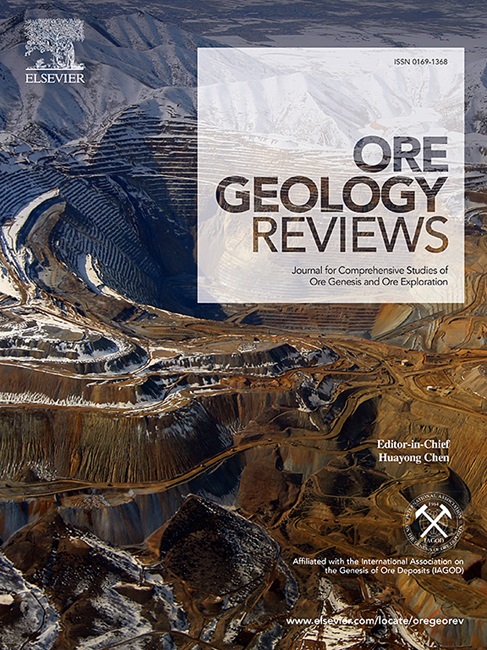Potassium isotope constraints on brine sources and evolution in Qaidam Basin, Tibetan Plateau
IF 3.2
2区 地球科学
Q1 GEOLOGY
引用次数: 0
Abstract
The genesis and evolutionary pathways of potassium resources in salt lakes form the scientific foundation for sustainable exploration and utilization of these critical mineral reserves. Potassium isotope system (δ41K), characterized by significant mass-dependent fractionation, has emerged as an effective tracer for investigating geological processes and material sources. This study presents a comprehensive geochemical investigation of brine salts, intercrystalline brines, and river waters collected from the Qaidam Basin on the northern Tibetan Plateau, China. The ion compositions, hydrochemical characteristics, and potassium isotopic compositions of the samples were analyzed. Analytical results reveal substantial spatial heterogeneity in potassium concentrations ([K+]) across different sample types, ranging from less than 0.01 × 103 mg L−1 to ∼21.12 × 103 mg L−1. A distinct [K+] hierarchy emerges: river samples < freshwater lakes < semi saline lakes < brine lakes < intercrystalline brines. Concurrent δ41K values exhibit significant variability (−0.77 ‰ to + 1.31 ‰), demonstrating systematic correlations with both [K+] concentrations and basin-scale structural features, as evidenced by comparative analysis with published δ7Li and δ11B datasets. Multivariate isotopic analysis (δ41K-δ7Li-δ11B) coupled with hydrochemical fingerprinting reveals a polygenetic potassium origin for Qaidam’s brine systems, involving: multiple mixture of rivers, deep groundwater via fractures (oil field brines, hot springs, etc.), and low-temperature weathering processes of K-rich rock. Notably, δ41K signatures show systematic differentiation between two major brine types. The δ41K values of chloride type salt lakes is relatively small (−0.57 ‰ to 0.22 ‰), whereas those in sulfate type salt lakes is much larger (−0.77 ‰ to 1.31 ‰). The results suggest that δ41K is a powerful tracer not only for indicating changes in sources but also for reflecting the evolutionary processes of brine.

青藏高原柴达木盆地卤水来源与演化的钾同位素制约因素
盐湖钾资源的成因和演化途径是盐湖关键矿产资源可持续开发利用的科学依据。钾同位素系统(δ41K)具有明显的质量依赖分馏特征,已成为研究地质过程和物质来源的有效示踪剂。本文对青藏高原北部柴达木盆地的卤盐、晶间卤水和河水进行了综合地球化学调查。分析了样品的离子组成、水化学特征和钾同位素组成。分析结果显示,不同样品类型的钾浓度([K+])存在显著的空间异质性,范围从小于0.01 × 103 mg L−1到~ 21.12 × 103 mg L−1。一个明显的[K+]层次结构出现了:河流样本<;淡水湖泊<;半盐湖<;咸水湖<;晶间卤水。与已发表的δ7Li和δ11B数据对比分析表明,同期δ41K值具有显著的变异(- 0.77‰~ + 1.31‰),与[K+]浓度和盆地尺度构造特征具有系统相关性。多元同位素分析(δ41K-δ7Li-δ11B)结合水化学指纹图谱揭示了柴达木卤水系统的多成因钾源,包括河流的多重混合、深部地下水(油田卤水、温泉等)以及富钾岩石的低温风化作用。值得注意的是,δ41K特征显示出两种主要卤水类型的系统区分。氯化物型盐湖δ41K值相对较小(−0.57‰~ 0.22‰),而硫酸盐型盐湖δ41K值较大(−0.77‰~ 1.31‰)。结果表明,δ41K不仅是指示卤水来源变化的有力示踪剂,而且是反映卤水演化过程的有力示踪剂。
本文章由计算机程序翻译,如有差异,请以英文原文为准。
求助全文
约1分钟内获得全文
求助全文
来源期刊

Ore Geology Reviews
地学-地质学
CiteScore
6.50
自引率
27.30%
发文量
546
审稿时长
22.9 weeks
期刊介绍:
Ore Geology Reviews aims to familiarize all earth scientists with recent advances in a number of interconnected disciplines related to the study of, and search for, ore deposits. The reviews range from brief to longer contributions, but the journal preferentially publishes manuscripts that fill the niche between the commonly shorter journal articles and the comprehensive book coverages, and thus has a special appeal to many authors and readers.
 求助内容:
求助内容: 应助结果提醒方式:
应助结果提醒方式:


